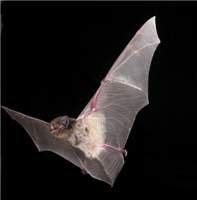Family
Molossidae
Genus
Tadarida
Species
australisThreats/Control Methods - Local
The increasingly limited number of nesting sites and competition for nesting sites with possums and pest birds such Common Mynas (Acridotheres tristis) and Starlings (Sternus vulgaris) may limit populations in urban areas. Domestic cats are also major suburban predators.
Local/Urban Actions
The protection of remnant vegetation containing dead and mature trees with hollows is important for maintaining bat populations. Participating in tree planting or bush regeneration activities with local Landcare groups or with Greening Australia will improve habitat areas into the future. Keeping cats inside or in a specially designed enclosure will help to reduce the risk of predation.Common name/s
White-striped Bat, White-striped Freetail Bat, White-striped Scurrying Bat
Distinguishing Features
This savage-looking species gets its name from its large, hound-like jowls and the distinct white stripes of fur under its wings. The White-striped variety is the largest of the Mastiff bats, with a head and body length of 9-10cm and a wingspan of 14 cm. Its back is chocolate brown coloured and its underparts are lighter. It has very large, fleshy, forward-pointing ears and a wrinkled upper lip. A pouch is present on the neck of both males and females.
Similar Species
The Little Mastiff-bat (Mormopterus planiceps) displays similar behaviour, however it is less vocal, smaller and grey in colour.
Distribution
This species is found across the southern half of mainland
Country of Origin
Australia
Survey Techniques
Calls
Conservation (Pet/Pest) Status - National
Secure, not listed under the EPBC Act 1999. The abundance of this species varies throughout its range.
Conservation (Pet/Pest) Status - Regional
Common
LSCCES Population
This was the most commonly recorded bat species in the Lower Sullivans Creek Catchment area.
Associated vegetation community
This species inhabits a variety of landscapes, including rainforest, eucalypt forest, along river corridors, woodland and in suburban areas.
Limiting Resources
The White-striped Mastiff-bat lives most successfully in regions with many mature hollow bearing eucalypts.
Breeding
Due to their secretive nature, little is known about the breeding behaviour of this species. Females are pregnant during spring and early summer, giving birth to one offspring at the end of the year. Their average life span is 5-7 years.
Behaviour
The White-striped Mastiff-bat is a nocturnal creature that can be seen flying high above the tree canopy in search of high-flying moths. They fly quickly and directly. Sometimes they will swoop down to the ground and scurry along the ground for insects. They usually roost in tree hollows in small groups, although occasionally individuals are found huddled under tree bark, in tree stumps or in building ceilings. It is one of the most vocal bat species to human ears, however in urban areas its call is often mistaken for 'pinging' power lines or insects.
Functional Group
Food Species
This species eats up to half its weight in insects every evening, providing a very important service to both urban residents and agriculturalists. It prefers moths, bugs and grasshoppers.
Interesting Fact
Despite its scary-looking appearance, this species is a very calm and tame animal to handle.
References - (reader suitability of references, P=Primary teachers, S=Secondary students, T=Tertiary students and researchers)
Books:Jackson, S. 2003. Australian Mammals: Biology and Captive Management. CSIRO Publishing. Collingwood VIC. S, T
Straham, R. (ed.) 1983. The Australian Museum Complete Book of Australian Mammals. The National Photographic Index of Australian Wildlife. Angus and Robertson Publishers. Sydney. P, S, T
Online Publications:Lumsden, L and Platt, S. 1991. Land for Wildlife Notes: Bats in Rural Victoria. State Government VIC. [online]. Available at:http://www.dpi.vic.gov.au/dpi/nreninf.nsf/9e58661e880ba9e44a256c640023eb2e/c06874633ff045a8ca2570180009713f/$FILE/Lw0012.pdf P, S, T
Tidemann, C., Roscoe, T. and Mitchell, B. 2006. Mammals of the Lower Sullivans Creek Catchment, Canberra ACT. Prepared for the Life in the Suburbs project using data from the Lower Sullivans Creek Catchment Ecological Survey (LSCCES). Australian National University. Canberra. [online]. Available at: http://www.lifeinthesuburbs.com.au/category.php?id=65 S, T
Researcher: Naomi Hogan

 Top
Top Top
Top